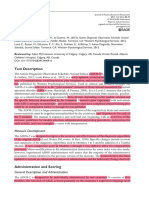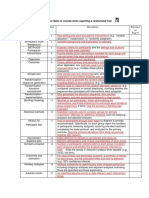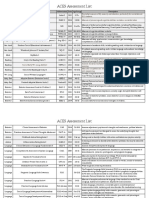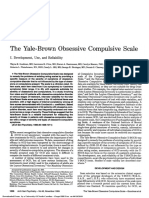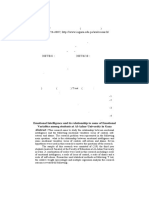0 ratings0% found this document useful (0 votes)
Scales of Independent Behavior-Revised
Scales of Independent Behavior-Revised
Uploaded by
clThe document summarizes two standardized adaptive behavior assessment scales: the Scales of Independent Behavior—Revised (SIB-R) and the Adaptive Behavior Diagnostic Scale (ABDS). The SIB-R assesses adaptive behaviors of individuals ages 3 months to 80+ years old. It yields standard scores in three domains: conceptual, social, and practical skills. The ABDS was recently released to assess individuals ages 2 to 21 years old. It has excellent reported psychometric properties but lacks independent validation. The Diagnostic Adaptive Behavior Scale (DABS) was designed to assist with diagnosing intellectual disability and provides a comprehensive assessment of current adaptive behaviors.
Copyright:
© All Rights Reserved
Available Formats
Download as PDF, TXT or read online from Scribd
Download as pdf or txt
Scales of Independent Behavior-Revised
Scales of Independent Behavior-Revised
Uploaded by
cl0 ratings0% found this document useful (0 votes)
The document summarizes two standardized adaptive behavior assessment scales: the Scales of Independent Behavior—Revised (SIB-R) and the Adaptive Behavior Diagnostic Scale (ABDS). The SIB-R assesses adaptive behaviors of individuals ages 3 months to 80+ years old. It yields standard scores in three domains: conceptual, social, and practical skills. The ABDS was recently released to assess individuals ages 2 to 21 years old. It has excellent reported psychometric properties but lacks independent validation. The Diagnostic Adaptive Behavior Scale (DABS) was designed to assist with diagnosing intellectual disability and provides a comprehensive assessment of current adaptive behaviors.
Original Description:
AB7
Original Title
7
Copyright
© © All Rights Reserved
Available Formats
PDF, TXT or read online from Scribd
Share this document
Did you find this document useful?
Is this content inappropriate?
The document summarizes two standardized adaptive behavior assessment scales: the Scales of Independent Behavior—Revised (SIB-R) and the Adaptive Behavior Diagnostic Scale (ABDS). The SIB-R assesses adaptive behaviors of individuals ages 3 months to 80+ years old. It yields standard scores in three domains: conceptual, social, and practical skills. The ABDS was recently released to assess individuals ages 2 to 21 years old. It has excellent reported psychometric properties but lacks independent validation. The Diagnostic Adaptive Behavior Scale (DABS) was designed to assist with diagnosing intellectual disability and provides a comprehensive assessment of current adaptive behaviors.
Copyright:
© All Rights Reserved
Available Formats
Download as PDF, TXT or read online from Scribd
Download as pdf or txt
0 ratings0% found this document useful (0 votes)
Scales of Independent Behavior-Revised
Scales of Independent Behavior-Revised
Uploaded by
clThe document summarizes two standardized adaptive behavior assessment scales: the Scales of Independent Behavior—Revised (SIB-R) and the Adaptive Behavior Diagnostic Scale (ABDS). The SIB-R assesses adaptive behaviors of individuals ages 3 months to 80+ years old. It yields standard scores in three domains: conceptual, social, and practical skills. The ABDS was recently released to assess individuals ages 2 to 21 years old. It has excellent reported psychometric properties but lacks independent validation. The Diagnostic Adaptive Behavior Scale (DABS) was designed to assist with diagnosing intellectual disability and provides a comprehensive assessment of current adaptive behaviors.
Copyright:
© All Rights Reserved
Available Formats
Download as PDF, TXT or read online from Scribd
Download as pdf or txt
You are on page 1/ 1
14 Adaptive Behavior 207
Scales of Independent Community scale that previously only had been
Behavior—Revised normed on adults with intellectual disability.
The ABDS is an interview-based scale that asses-
The Scales of Independent Behavior—Revised ses the adaptive behavior of individuals between
(SIB-R; Buininks et al., 1996) is a comprehen- the ages of 2 and 21 years and is normed on a
sive standardized adaptive behavior scale that typically developed population. The structure of
was standardized on a representative sample of the scale includes the three prevalent domains,
individuals from the general population. It was including Conceptual, Social, and Practical Skills.
developed for use with individuals from The scale administration is structured according to
3 months to 80+ years old and consists of three these three domains and each domain consists of
separate forms: Early Development (3 months– 50 discrete adaptive skills. The results obtained
8 years old), Comprehensive Form (3 months– yield standard scores with a mean = 100 and
80 years old) and Short Form. The Develop- standard deviation = 15 for each of the three
mental Form and Short Form are a different domains: Conceptual, Social, and Practical as well
subset of 40 items drawn from the full SIB-R as an overall Adaptive Behavior Index.
instrument. The SIB-R may be administered Having only been recently released, there
using the structured interview or a checklist exists no independent psychometric evaluation of
procedure where the respondent completes the the ABDS. The authors (Pearson et al., 2016)
questionnaire directly. report excellent psychometric properties, includ-
The SIB-R full-form contains two sections: ing internal consistency coefficients for all
adaptive behavior items and problem behavior domain and overall index standard scores above
items. The adaptive behavior contains a total of 0.90. The authors also reported a sensitivity
259 and yields a total standard scores called coefficient of 0.85 and specificity coefficient of
Broad Independence and 4 domain scores: Motor 0.99.
Skills, Social Interaction and Communication A review of the scale and its user’s manual
Skills, Personal Living Skills, and Community supports the use of the ABDS for use in
Living Skills. The problem behavior section obtaining standardized adaptive behavior
contains 8 distinct challenging behaviors rated assessment information for the purpose of mak-
for their frequency (0–5) and severity (0–4). The ing an intellectual disability determination.
SIB-R requires approximately 60 min to com-
plete and may be completed either as a rating
scale directly by the respondent or via an inter- Diagnostic Adaptive Behavior Scale
view between an interviewer and a respondent.
Although the reliability and validity psycho- The Diagnostic Adaptive Behavior Scale
metric data for the Comprehensive Form are (DABS; Tassé, Schalock, Balboni, Bersani,
adequate, the psychometric properties of the Borthwick-Duffy, Spreat, Thissen, Widaman, &
Short Form and Developmental Form are ques- Zhang, in press) was designed specifically for the
tionable (Maccow, 2001). purpose of being a standardized assessment
instrument to assist with the diagnosis of intel-
lectual disability. The DABS was designed from
Adaptive Behavior Diagnostic Scale its earliest conception to assist in the ruling in or
ruling out of intellectual disability (formerly
The Adaptive Behavior Diagnostic Scale (ABDS; mental retardation) by providing a comprehen-
Pearson, Patton, & Mruzek, 2016) is a recently sive assessment of an individual’s current adap-
released standardized adaptive behavior scale tive behavior and be most precise and reliable at
(Pearson, Patton, & Mruzek, 2016). It is a the cutoff score that is equivalent to 2 standard
replacement adaptive behavior scale for deviations below the population mean.
PRO-ED’s Adaptive Behavior Scale—Residential The DABS was developed based upon the
You might also like
- Topic 4: Addiction Screening and Assessment Tools ChartNo ratings yetTopic 4: Addiction Screening and Assessment Tools Chart7 pages
- The California Verbal Learning Test andNo ratings yetThe California Verbal Learning Test and13 pages
- MoCA Basic English FINAL VERSION 4 June 2014 PDF100% (1)MoCA Basic English FINAL VERSION 4 June 2014 PDF2 pages
- ( (#Ve?@ (2 ( (#Ve?@ (G ( (#Ve?@ (M (R6 (,cbwxcd@yz (KG54GN ( (V/6L (No ratings yet( (#Ve?@ (2 ( (#Ve?@ (G ( (#Ve?@ (M (R6 (,cbwxcd@yz (KG54GN ( (V/6L (1 page
- Autism Spectrum Quotient (AQ) : Definitely Agree Slightly Agree Slightly Disagree Definitely DisagreeNo ratings yetAutism Spectrum Quotient (AQ) : Definitely Agree Slightly Agree Slightly Disagree Definitely Disagree1 page
- CHC: Domain-Independent Capacities: The CHC Periodic Table of Human AbilitiesNo ratings yetCHC: Domain-Independent Capacities: The CHC Periodic Table of Human Abilities3 pages
- Rey-Auditory Verbal Learning Test (RAVLT, Wordlist 2) - English VersionNo ratings yetRey-Auditory Verbal Learning Test (RAVLT, Wordlist 2) - English Version3 pages
- The Infant-Toddler Social and Emotional Assessment (ITSEA) : Factor Structure, Reliability, and ValidityNo ratings yetThe Infant-Toddler Social and Emotional Assessment (ITSEA) : Factor Structure, Reliability, and Validity21 pages
- NBSE Evidence-Based Review Test Summary TablesNo ratings yetNBSE Evidence-Based Review Test Summary Tables82 pages
- Child Neuropsychology Volume 16 Issue 1 2009 (Doi 10.1080 - 09297040903146966) Brooks, Brian L. Sherman, Elisabeth M. S. Strauss, Esther - NEPSY-II - A Developmental NeuropsychologNo ratings yetChild Neuropsychology Volume 16 Issue 1 2009 (Doi 10.1080 - 09297040903146966) Brooks, Brian L. Sherman, Elisabeth M. S. Strauss, Esther - NEPSY-II - A Developmental Neuropsycholog24 pages
- Hand Exercises To Help With Writing and Fine Motor DifficultiesNo ratings yetHand Exercises To Help With Writing and Fine Motor Difficulties2 pages
- Neuropsychological Assessment Clinial InterviewNo ratings yetNeuropsychological Assessment Clinial Interview11 pages
- The SQLSSelf-report Quality of Life Measure For People With SchizophreniaNo ratings yetThe SQLSSelf-report Quality of Life Measure For People With Schizophrenia6 pages
- The Yale-Brown Obsessive Compulsive Scale I. Development, Use, and ReliabilityNo ratings yetThe Yale-Brown Obsessive Compulsive Scale I. Development, Use, and Reliability6 pages
- OB Movie Analysis (The Pursuit of Happiness)No ratings yetOB Movie Analysis (The Pursuit of Happiness)6 pages
- Test Bank For Theory and Practice of Counseling and Psychotherapy, 11th Edition Gerald CoreyNo ratings yetTest Bank For Theory and Practice of Counseling and Psychotherapy, 11th Edition Gerald Corey11 pages
- Visceral-sensitivity--hunger-responsiveness--and-satiety-responsiven_2024_ApNo ratings yetVisceral-sensitivity--hunger-responsiveness--and-satiety-responsiven_2024_Ap10 pages
- Unit 15 Behavioural Problems of Students: StructureNo ratings yetUnit 15 Behavioural Problems of Students: Structure19 pages
- Qualities or Characteristics Desired in An Assessment InstrumentNo ratings yetQualities or Characteristics Desired in An Assessment Instrument7 pages
- Arguments for and Against Existence of God.No ratings yetArguments for and Against Existence of God.823 pages
- Child and Ado and Faci... Sample LET Questions100% (2)Child and Ado and Faci... Sample LET Questions10 pages
- SocialDysphoriaAcceptedCopyStigmaHealth PDFNo ratings yetSocialDysphoriaAcceptedCopyStigmaHealth PDF36 pages
- (Cô Vũ Mai Phương) Dự Đoán Đặc Biệt Câu Hỏi Collocation Trong Đề Thi (Buổi 2)No ratings yet(Cô Vũ Mai Phương) Dự Đoán Đặc Biệt Câu Hỏi Collocation Trong Đề Thi (Buổi 2)2 pages









